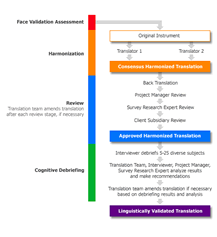
Linguistic Validation
Harmonization Process
- Two translators who are native speakers of the target language and are experienced in translating health questionnaires independently translate the document.
- After both translations are complete, the two translators compare their translations and produce a third translation jointly. This process of discussion and review is known as "harmonizing" and the resulting third translation is referred to as the "harmonized translation."

- The harmonized translation is then given to a native English-speaking translator for translation back into English. This document is referred to as the "back-translation."
- A project manager compares the original English to the back-translation and either approves or questions each item in the back-translation.
- The project manager discusses concerns with the three translators, who may change the translation, change the back-translation, or leave the translation as it is, providing a justification to the project manager. A new harmonized translation and back-translation may be created.
- A survey research expert (or author, if available) compares the original English to the harmonized back-translation and either approves or questions each item.
- If portions of the back-translation are not approved, then the translation is sent back to the three translators who may change the translation, change the back-translation, or leave the translation as it is, providing a justification to the survey research expert. This process is repeated until all translation issues have been resolved and the revised back-translation is approved.
- Local users selected by the client review the translation to identify any additional concerns. If the local user requests changes, steps 1-3 are repeated until all concerns have been addressed and all revisions are approved by the survey research expert.
Cognitive Debriefing
- An independent survey research expert develops a project-specific debriefing protocol tailored to any issues surrounding the target questionnaires, the subject pool, or mode of administration, e.g., procedures for subjects with or without a target disease, anticipated problem items, and in-person or telephone interviews.
- The survey research expert trains bilingual interviewers to conduct cognitive debriefing interviews according to the protocol and standard interviewing techniques. Interviewers conduct practice interviews and their skills are evaluated.
- For each language, five native speakers (minimum) not involved in the translation process are recruited as debriefing subjects. Subjects are selected to be diverse as to age, gender, employment status, and educational level.
- The interviewer conducts the debriefing interviews according to the protocol and assesses the clarity and acceptability of the questionnaire, e.g., in terms of missing and inconsistent responses and subjects' difficulty understanding questions or making responses.
- The survey research expert summarizes results of the debriefings and makes recommendations for approval, additional testing or re-translation. Harmonization repeated as necessary until the survey research expert, project manager, translators, and interviewers are in agreement.
- A summary report is created detailing methodology used as well as the results of the cognitive debriefing after Steps 1-5 have been completed.

